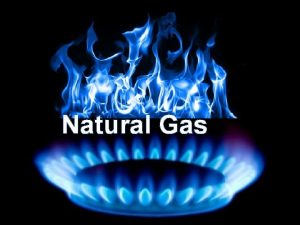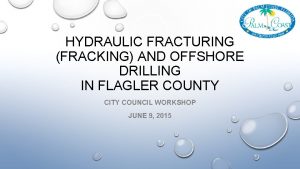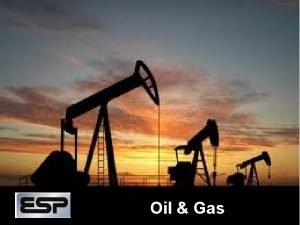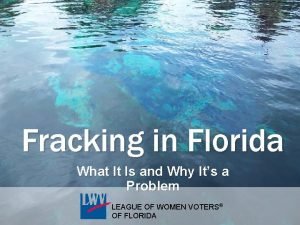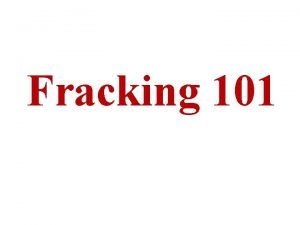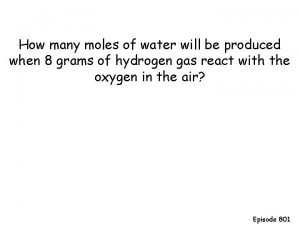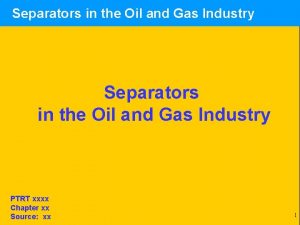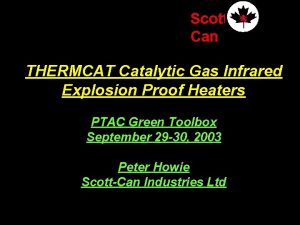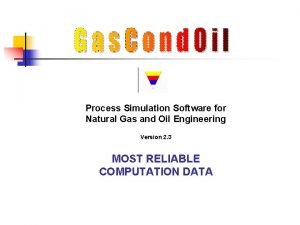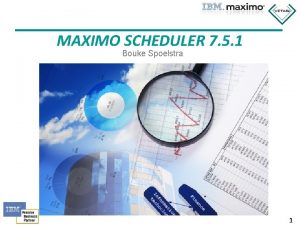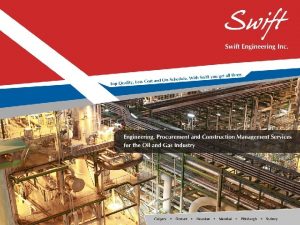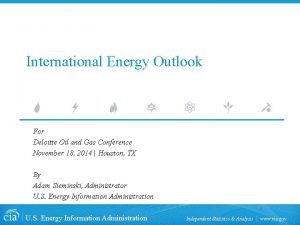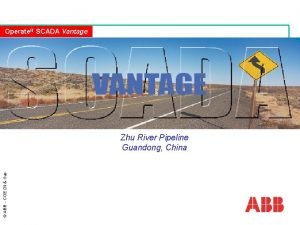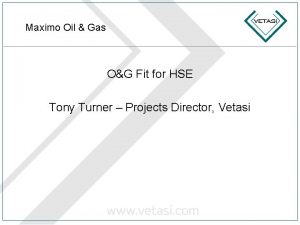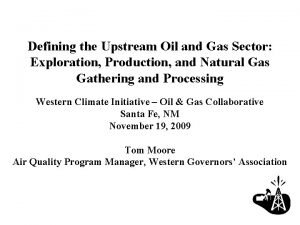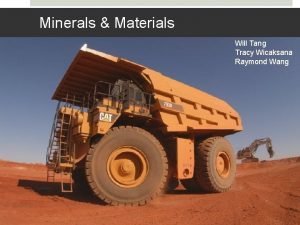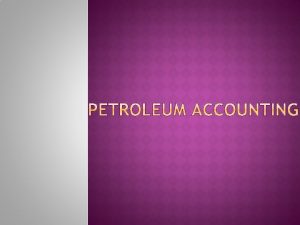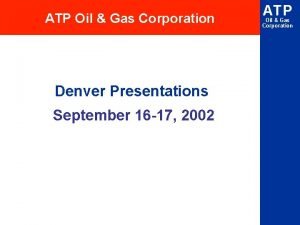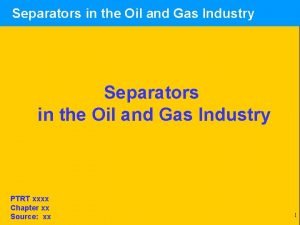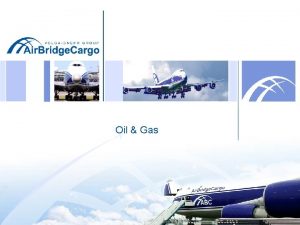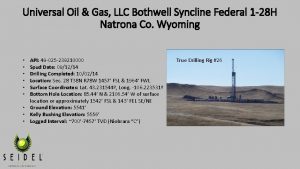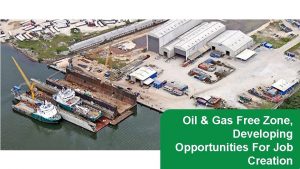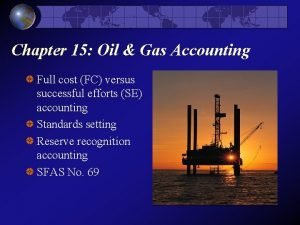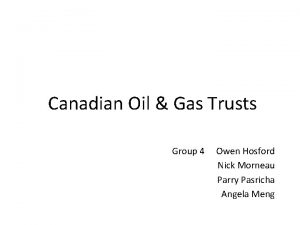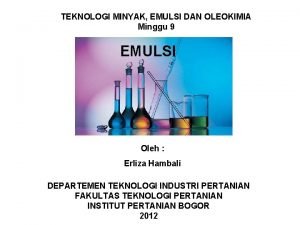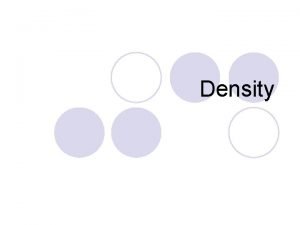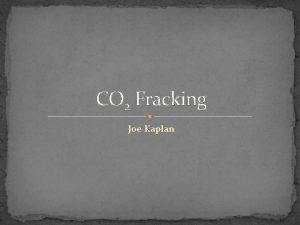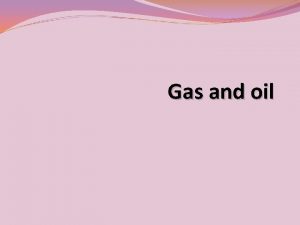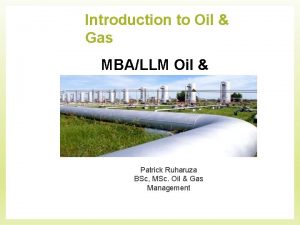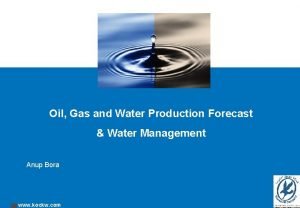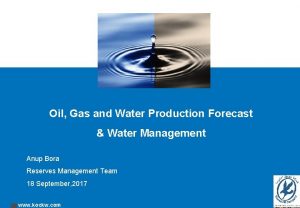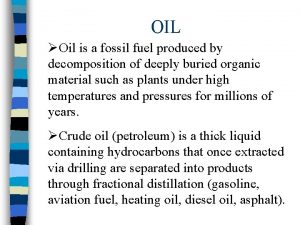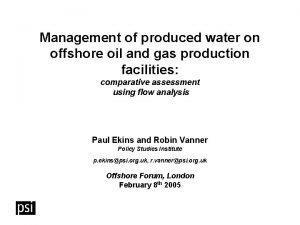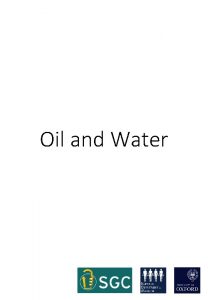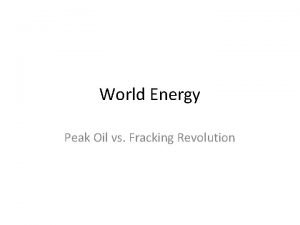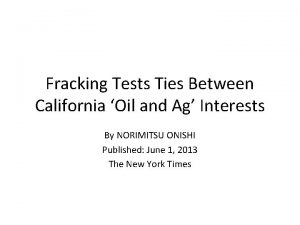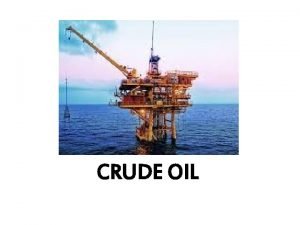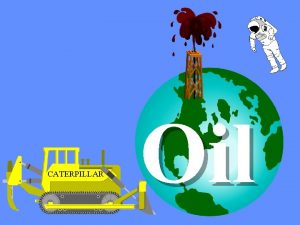Management of Produced Water from Fracking Oil Gas





















































- Slides: 53

Management of Produced Water from Fracking, Oil & Gas Activities Across the States Susan Miller Bisong, Esq. Modrall Sperling Law Firm Albuquerque, New Mexico

• Insert picture of Leo

Produced Water Definition Section 1

What is Produced Water? • Water naturally occurring in rock formations where oil is located. • “Flowback water” Water previously injected into a formation during fracking or secondary recovery to increase oil and gas production, including chemicals added during the production process.

Unconventional v. Conventional Oil and Gas Wells

Oil Production in the United States • As of 2019, the U. S. is the world’s largest oil producer • Domestic crude production has doubled since 2011 from 5. 2 million barrels per day (bbls/day) to over 11. 6 million bbls/day Sources: US Energy Information Administration Top states for onshore oil production: Texas Wyoming North Dakota Louisiana New Mexico Utah Oklahoma California Colorado Alaska

Natural Gas Production in the United States • As of 2009, the US was the largest natural gas producer in the world Top natural gas producing states (as of September 2019) Texas Pennsylvania Louisiana Oklahoma Ohio (Other countries have greater natural gas reserves) https: //www. eia. gov/dnav/ng/ng_prod_sum_a_EPG 0_FGW_mmcf_m. htm Alaska Colorado Wyoming New Mexico West Virginia

Use of Water in Oil and Gas Production • Enhanced Oil Recovery – or EOR – is the process of increasing the amount of oil that can be recovered from an oil reservoir, usually by injecting a substance into an existing oil well to increase pressure and reduce the viscosity of the oil. • Hydraulic fracturing (fracking) is not commonly considered a form of EOR. Fracking and other forms of well stimulation, permanently change the geology of the formation, creating new pathways for oil or gas to flow.

How Produced Water is used for Fracking

Volumes of Produced Water Generated • Since 2009, volumes of produced water have increased considerably • Best available data from 2012 indicates nearly 1 million producing wells in U. S. generate approximately 21. 2 billion bbls per year • 890 billion gallons per day • 2. 7 million acre feet per year Groundwater Protection Council Produced Water Report, June 2019

Chemical Composition of Produced Water Contents of formation water (vary by formation across the U. S. ) • Salts, including those composed from chloride, bromide, sulfate, sodium, magnesium, and calcium • Metals, including barium, manganese, iron, strontium • Naturally occurring organic compounds, including benzene, toluene, ethylbenzene, xylenes and oil and grease • Radioactive materials, including radium • Hydraulic fracturing chemicals See EPA Management of Exploration, Development and Production Wastes – section 5 -18

Additives Used in Well Development, Stimulation and Maintenance

Salinity of Produced Water • Total Dissolved Solids range from 3, 000 mg/L to over 300, 000 mg/L • Ocean water is typically about 35, 000 mg/L • Waters with very high salinity are very difficult to treat for uses other than for oil and gas production • Treatment results in a large quantity of very concentrated waste products that require appropriate disposal

Management Options Section 3

Oil and Gas Producing Basins in the U. S. (Map from Groundwater Protection Council Produced Water Report)

Disposal/Reuse Methods • Saltwater Disposal Wells • Discharge to Surface Water • Evaporation • Reuse/Recycle - Oil and Gas Production Dust Control Agriculture/Wildlife Industrial Use

Management Practices for Produced Water (John Veil, April 2015, “U. S. Produced Water Volumes and Management Practices in 2012 )

Injection Into Salt-Water Disposal Wells • Regulated under the federal Safe Drinking Water Act • In many areas most cost efficient way to manage produced water • Depends on Cost Pore space Availability of fresh water and need for recycling


Salt Water Disposal Wells • • • Need permeable formations that allow sufficient injection rates Seismicity if near fault line Difficult permitting process Loss of potentially valuable resource BUT Compliments water reuse systems if produced water volume exceeds what is usable Used if reuse impractical

Reuse in Oil and Gas Production • • • Generally governed by State laws and regulations and under the SWDA Not regulated under Clean Water Act Treated minimally May remove some TDS Addition of various chemicals and sand

Treatment for Other Uses • Regulated by Clean Water Act and state laws • Livestock Watering Stream Augmentation Dust control Agricultural use • • Some states do not allow for reuse for uses other than oil and gas industries

Discharge to Surface Water • Regulated under Clean Water Act - NPDES permit required • Prohibited in the eastern half of the U. S. by EPA guidelines and NPDES permits • Discharge to surface water occurring currently in Wyoming under EPA regulation 40 CFR 435 subpart E

Federal Laws Section 4

Federal Laws Pertaining To Produced Water • Safe Drinking Water Act, 42 U. S. C. § 300 f et seq. • Resource Conservation and Recovery Act (RCRA) 42 U. S. C § 6901 et seq. • Clean Water Act, 33 U. S. C. § 1251 et seq.

Safe Drinking Water Act • Protects quality of surface and underground sources of drinking water • EPA regulates salt water disposal wells through the Underground Injection Control (UIC) Program • 6 classes of regulated wells with different restrictions, requirements and responsible permitting agencies • Disposal wells injecting fluids associated with oil and gas production are included in Class II

Safe Drinking Water Act • EPA/state regulations for Class II wells includes: • site location and • construction requirements, • operating standards, • monitoring and reporting requirements and • closure post-closure requirements • Some states have primacy (primary permitting and enforcement authority designated by the EPA) for Class II wells

Resource Conservation and Recovery Act (RCRA) • EPA has “cradle to grave” authority to control hazardous and solid waste • Produced water is considered a nonhazardous solid waste under RCRA • Regulated under Subtitle D of RCRA as a non-hazardous solid waste • Solid waste can include solids, liquids and gases and must be discarded to be considered waste

RCRA • States play the lead role in implementing non-hazardous waste programs under subtitle D • EPA has developed regulations to set minimum national technical standards for how disposal facilities should be designed and operated • States issue permits to ensure compliance with EPA and state regulations

Clean Water Act • • • Strict controls for discharge of produced water into Waters of the U. S. Establishes general water quality standards for surface waters Requires permits for discharge into waters of the United States

Clean Water Act • • Permits for discharge of produced water to waters of the United States issued under the National Pollutant Discharge Elimination System (NPDES) CWA establishes technology based effluent limitations guidelines (ELGs) and standards for all discharges in the NPDES system

EPA Regulations for Facilities Treating Produced Water • 40 CFR Part 435 (Oil and Gas Extraction Effluent Limitation Guidelines or ELGs) • 40 CFR Part 437 (Centralized Waste Treatment ELGs)

Oil and Gas Extraction ELGs • Oil and Gas Extraction ELGs impose treatment standards on produced water • Standards in guidelines incorporated into NPDES permits • ELGs prohibit direct discharges of wastewater pollutants from onshore hydraulic fracturing facilities. 40 C. F. R. § 435. 32 • Prohibits indirect discharge of fracturing fluids to publicly owned treatment works (POTWs). 40 C. F. R. § 435. 33(a)(1)

Oil and Gas Extraction ELGs • There is an Agricultural and Wildlife Water Use Subcategory (40 CFR Part 435, subpart E) • Allows for direct discharge of produced water for Ag and wildlife use in the western U. S. • Must have a daily maximum limitation of 35 mg/L for oil and grease and must be of “good enough quality for wildlife or agricultural use. ”

The 98 th Meridian

Centralized Waste Treatment Facilities • Produced water may be treated by off-site Centralized Waste Treatment Facilities • 40 CFR Part 437 regulates direct and indirect discharge by off-site Centralized Waste Treatment Facilities • 40 CFR § 437. 2 defines CWT as “any facility that treats (for disposal, recycling or recovery of material) any hazardous or nonhazardous industrial waste; hazardous or nonhazardous industrial wastewater and/or used material received from offsite. ”

Centralized Waste Treatment Facility ELGs • EPA considering amendments to 40 CFR part 437 • Only about 11 facilities currently permitted under this section according to EPA • Current CWT ELGs do not contain limitations for many of the pollutants commonly found in fracking fluids • Discharge limitations in permits are not consistent across the industry because different facilities have different types of permits

Centralized Waste Treatment Facility ELGs • ELGs cover discharges from facilities that treat or recover metal-bearing, oily, and organic wastes, wastewater, or used material received from off-site. 40 C. F. R. §§ 437. 10 - 437. 47 • The CWT Effluent Guidelines and Standards are incorporated into NPDES permits for direct dischargers, and permits or other control mechanisms for indirect dischargers.


State Laws Section 5

Marcellus/Utica Shale • Conventional oil and gas development not successful • Unconventional development became very successful in 2005 • In Pennsylvania, UIC program controlled by EPA Region 3, not by Pennsylvania Department of Environmental Protection under 40 C. F. R. § 144. 1(e), 147. 1951(a) • Injection not an option like it is in other major shale play regions

Marcellus/Utica Shale • Pennsylvania arguably has the most comprehensive set of regulations governing storage, treatment and transportation of produced water • Even when being reused or recycled, PA treats produced water as a solid waste under its solid waste program • Temporary storage or processing of produced water requires a solid waste permit and facilities engaging in these activities are considered solid waste transfer facilities • PA Dept. Environmental Protection has issued a beneficial reuse general permit for facilities that transfer, process and use produced water to hydraulically fracture gas wells known as WMGR 123

Marcellus/Utica Shale • Options are to haul water to Ohio, haul to nearby industrial wastewater treatment facility, haul to municipal wastewater treatment plant • Cost of disposal in Ohio injection well costly due mostly to transportation costs • In 2017, less than 6% of produced water from fracking was injected into disposal wells

Permian • Approximately 250 miles wide and 300 miles long in West Texas and Eastern New Mexico • Largest petroleum producing basin in the U. S. • In 2018 alone generated over 1 billion bbls of produced water • According to EIA, as of December of 2018, the Permian Basin had 485 active drill rigs (45% of the U. S. and 23% or world-wide rigs) • Estimated reserves are 43 billion barrels of oil and 18 trillion cubic feet of gas • Hydraulic fracturing through unconventional wells started booming in 2011

New Mexico Produced Water Act provides that: 1. All produced water from oil and gas wells is the responsibility of and under the control of the well’s working interest owners and operators, who shall have “a possessory interest” in the produced water. 2. Upon transfer (by sale or other conveyance) of produced water to other entities within the produced water business, the transferee obtains the same control of, possessory interest in and responsibility and liability for the produced water 3. Same rules apply to operators and transferees who take possession of produced water for the purpose of recycling or treating the water

EPA New Mexico Memorandum: Governance of Produced Water • In July 2018, EPA and New Mexico entered into a Memorandum of Understanding to clarify the existing regulatory and permitting frameworks related to the way produced water from oil and gas extraction activities can be reused, recycled and renewed for other purposes • White Paper

Haynesville • Second largest natural gas field in the U. S. behind Marcellus/Utica • Companies generally not reusing produced water due to salinity and costs for treatment • Most produced water is trucked to SWD wells for disposal • Fresh water from Sabine River and lakes used for fracking • Companies try to reduce cost by working with river authorities to enter into multi-year take or pay contracts, limiting transport distances for produced water and using third-party disposal wells

Haynesville The Louisiana Department of Natural Resources is responsible for regulating fracking in Louisiana. The department enforces regulations on the following: • Well construction, casing, and cementing • Protection of underground and surface water • Reporting and disclosure of fracking fluids (including volume and a description of each chemical additive used) • The maximum amount of surface and injecting pressure used during the process • Spill prevention and clean-up • All other information considered necessary for the regulation of fracking for safety and environmental protection

Haynesville • Louisiana Department of Natural Resources requires work permits for hydraulic fracturing • Chemicals have to be reported to Frac Focus.

Haynesville • The Exploration & Production Waste Management Section of the Office of Conservation is responsible for implementation of regulatory controls for commercial Exploration & Production (E&P) Waste storage, treatment, and disposal facilities. • The E & P Waste Management Section also coordinates all UIC related enforcement actions brought against commercial Class II injection well operators who violate rules and regulations. Commercial E&P Waste facility operations may include the use of various treatment and disposal options such as Class II injection well disposal, land treatment, phase separation, chemical fixation, thermal desorption, cavern disposal or incineration.

Future of Produced Water Management Reuse for EOR and fracking is increasing in places like the Permian due scare water supplies and booming oil and gas activity Use of fresh water sources for fracking is decreasing as use of brackish water and reuse of produced water increases Discharge to surface waters – not done outside of Wyoming for the most part. Disposal through salt water disposal wells still increasing – even in places like the Permian even where reuse increasing Also increasing is evaporation in impoundments

Q&A

 Fracking natural gas
Fracking natural gas Offshore drilling
Offshore drilling Water and water and water water
Water and water and water water Pros cons of biomass energy
Pros cons of biomass energy Fracking explained
Fracking explained Fracking
Fracking Fracking 101
Fracking 101 Fracking apes
Fracking apes Risk management case study oil and gas industry
Risk management case study oil and gas industry How to prevent creaming in emulsion
How to prevent creaming in emulsion Aluminum iodide
Aluminum iodide To cook by the vapor produced from boiling water
To cook by the vapor produced from boiling water Types of separators in oil and gas industry
Types of separators in oil and gas industry Catalytic heater oil and gas
Catalytic heater oil and gas Oil and gas process simulation software
Oil and gas process simulation software [email protected]
[email protected] Maximo assignment manager application
Maximo assignment manager application Maximo hse
Maximo hse Madagascar oil and gas
Madagascar oil and gas Oil & gas engineering services
Oil & gas engineering services Deloitte oil and gas outlook
Deloitte oil and gas outlook Classification of inhalational agents
Classification of inhalational agents Hitachi vantara oil and gas
Hitachi vantara oil and gas Drops oil and gas
Drops oil and gas Uses of oil and gas
Uses of oil and gas Atb oil and gas
Atb oil and gas Echometer oil and gas
Echometer oil and gas Abb scadavantage
Abb scadavantage Osu oil and gas accounting conference
Osu oil and gas accounting conference Mobile ibm maximo scheduler tool
Mobile ibm maximo scheduler tool Maximo for oil and gas
Maximo for oil and gas Energy roles
Energy roles Oil and gas
Oil and gas Oil and gas revenue accounting basics
Oil and gas revenue accounting basics Dylan prins
Dylan prins Oil and gas company
Oil and gas company Ibm maximo for oil and gas
Ibm maximo for oil and gas Due diligence checklist for oil and gas properties
Due diligence checklist for oil and gas properties Diversifying oil and gas portfolio
Diversifying oil and gas portfolio Full cost method oil and gas
Full cost method oil and gas Gas 101
Gas 101 Types of separators in oil and gas industry
Types of separators in oil and gas industry Oil and gas supply chain challenges
Oil and gas supply chain challenges Oil gas
Oil gas Universal oil and gas
Universal oil and gas Wvges pipeline plus
Wvges pipeline plus Oil and gas free zone authority recruitment
Oil and gas free zone authority recruitment Full cost accounting oil and gas
Full cost accounting oil and gas Oil sands extraction process diagram
Oil sands extraction process diagram Faktor-faktor yang mempengaruhi ketidakstabilan emulsi
Faktor-faktor yang mempengaruhi ketidakstabilan emulsi Petrotech southeast
Petrotech southeast Is oil more dense than water
Is oil more dense than water Is oil more dense than water
Is oil more dense than water Is oil more dense than water
Is oil more dense than water
